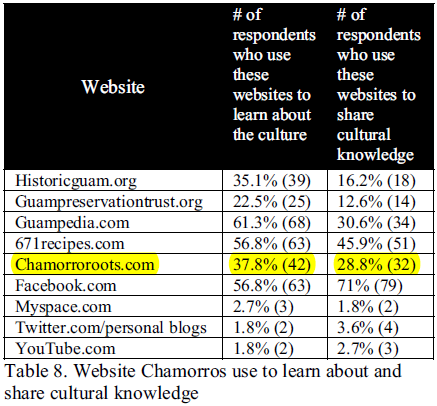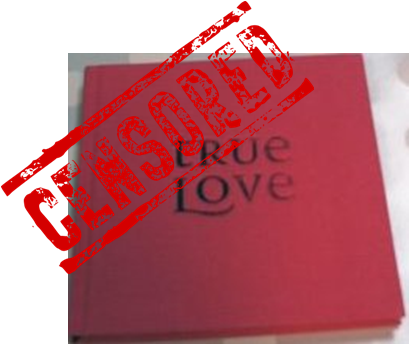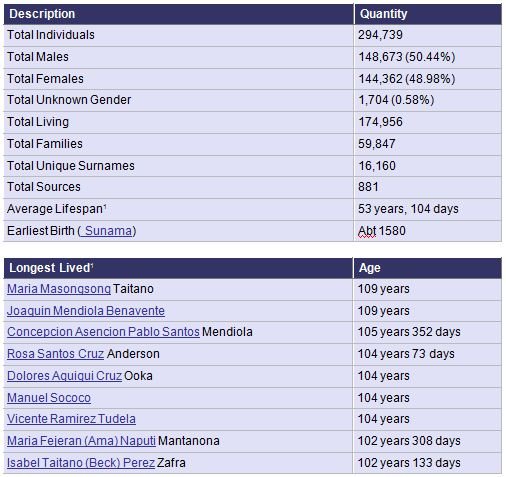Home
Memorial Day & Wake Island Defenders From Guam
- Details
In memory of all the Chamorro people who have in one way or another made sacrifices during a time of unfortunate war. Our condolences and prayers are with the families of Corporal Dwayne W. Flores and Sergeant Eugene Aguon. God Bless them all as we honor them on Memorial Day!
1940 Census and Wake Island Defenders from Guam...
 A while back ago I wrote one of the significances of the 1940 Census is that we can get a glimpse of where most people resided prior to World War II.
A while back ago I wrote one of the significances of the 1940 Census is that we can get a glimpse of where most people resided prior to World War II.
As I continue to transcribe the 1940 Census of Guam, I have noted that some people were enumerated as absent "ab." What's interesting to this category of Chamorros is that some of them were Pan American Airways employees were either working on Midway or Wake Island. Not too long after, some even became known as the "Wake Island Defenders," when World War II in the Pacific broke loose on 8 December 1941. This particular Census image shows Silvestre Arriola Sablan as absent with his family from Sumay.
If you research beyond the Census of Guam you will find some the names of these Chamorros also enumerated in Midway Island, within the Hawaii Census, "Pan American Airways Compound." This is also where I found Silvestre Arriola Sablan listed as a Mechanic on Midway Island.
Sablan is also listed as a Wake Island Defender in "I Manfåyi: Who's Who in Chamorro History Volume II (Hale’ta), 1997. He was killed in action on Wake Island.
There were 45 Chamorro men working for Pan Am on Wake Island. 10 were killed on the first day the Japanese attacked Wake Island. The remaining 35 helped to defend the Island, but were all captured and sent to prison camps in Japan and then to China. Two men died as prisoners of war while confined to the camp.
 It was not until 1982 under Public Law 95-202, when the U.S. recognized these Chamorro men and granted them military veteran status. Mr. Francisco Chaco Carbullido is the last remaining survivor of the Defenders. He is also the father of the Honorable Chief Justice F. Phillip Carbullido.
It was not until 1982 under Public Law 95-202, when the U.S. recognized these Chamorro men and granted them military veteran status. Mr. Francisco Chaco Carbullido is the last remaining survivor of the Defenders. He is also the father of the Honorable Chief Justice F. Phillip Carbullido.
The following is a list of the “Wake Island Defenders from Guam:”
|
Aguon |
Pedro F. |
Survivor |
|
Aquiningoc |
Antonio T. |
Survivor |
|
Baleto |
Jesus C. |
Survivor |
|
Blanco |
Francisco M. |
Killed in action |
|
Blas |
Emeterio O. |
Survivor |
|
Blas |
Jose P. |
Killed in action |
|
Cabrera |
Juan M. |
Killed in action |
|
Camacho |
Alfonso Meno |
Survivor |
|
Camacho |
Jesus P. |
Died in POW camp |
|
Carbullido |
Francisco Chaco |
Survivor |
|
Concepcion |
Jose M. |
Survivor |
|
Cruz |
Felix R. |
Survivor |
|
Flores |
James William |
Killed in action |
|
Flores |
Joseph C. |
Survivor |
|
Garcia |
Jesus A. |
Survivor |
|
Garrido |
Enrique S. |
Survivor |
|
Garrido |
Vicente A. |
Survivor |
|
Guerrero |
Felipe C. |
Killed in action |
|
Guerrero |
Manuel C. |
Survivor |
|
Iriarte |
Tomas D. |
Survivor |
|
Leon Guerrero |
Balvino D. |
Survivor |
|
Lizama |
Jose Q. |
Survivor |
|
Mafnas |
Jose S. |
Killed in action |
|
Manalisay |
Francisco T. |
Killed in action |
|
Manibusan |
Vicente C. |
Killed in action |
|
Marion |
Edward B. |
Survivor |
|
Mendiola |
Pedro P. |
Survivor |
|
Mendiola |
Sergio Maanao |
Survivor |
|
Mesa |
Vicente C. |
Survivor |
|
Namauleg |
Antonio E. |
Survivor |
|
Naputi |
Jesus B. |
Survivor |
|
Pablo |
Serafin A. |
Survivor |
|
Peredo |
Antonio Mendiola |
Survivor |
|
Quan |
Gregorio C. |
Killed in action |
|
Quidachay |
Juan R. |
Survivor |
|
Quinata |
Francisco B. |
Survivor |
|
Reyes |
Ignacio C. |
Survivor |
|
Rivera |
Juan U. |
Survivor |
|
Sablan |
Silvestre A. |
Killed in action |
|
Salas |
Joaquin C. |
Survivor |
|
San Nicolas |
Jose T. |
Survivor |
|
Santos |
Roque T. |
Survivor |
|
Taijeron |
Geronimo S. |
Died in POW camp |
|
Taijeron |
Vicente |
Survivor |
|
Villlagomez |
Francisco P. |
Survivor |
Sinaro & Ancient Chamorro Justice
- Details
 According to Fray Juan Pobre in 1602, Sinaro was a Chamorro from the village of Guaco, Rota. Sinaro speared a Spaniard named Sancho after being ridiculed and humiliated by him. Apparently Mågå'låhi Sunama of Tazga was Sancho's master or friend.
According to Fray Juan Pobre in 1602, Sinaro was a Chamorro from the village of Guaco, Rota. Sinaro speared a Spaniard named Sancho after being ridiculed and humiliated by him. Apparently Mågå'låhi Sunama of Tazga was Sancho's master or friend.
Sancho died from his wound and Sunama's family gave him a Chamorri burial. Spears were placed in the ground in front of Sancho's grave as a symbol of alerting the people of Tazga and warning the people of Guaco that they would avenge Sancho's death. Even Mågå'låhi Toca of Guaco denounced Sinaro as a bad person.
As a cultural practice of what seemed to have been a form of Chamorro justice, Sinaro made a trip to Guam to retrieve a tortoise shell, a few fish, and other things to offer Sunama and his family in an attempt to make amends over Sancho's death.
References:
Judith R. Amesbury & Rosalind L. Hunter-Anderson. 2003. Review of Archaeological and Historical Data Concerning Reef Fishing in the U.S. Flag Islands of Micronesia: Guam and the Northern Mariana Islands (Final Report). Western Pacific Fishery Management Council.
Lawrence Cunningham. 1992. Ancient Chamorro Society. Best Press: Hawaii
Si Yu’os Ma’ase: Capturing & Conveying Chamorro Cultural Knowledge
- Details
On June 1, 2012 I was contacted by Dr. Tonia San Nicolas-Rocca to help her reach out to the Chamorro community to complete a survey for her research in an attempt to explain the importance of information and communication technologies. More specifically her efforts focused on capturing and conveying indigenous cultural knowledge through a case study within the Chamorro people from Guam.
Once again, while performing a random search on the internet, I came across an abstract of Dr. Tonia San Nicolas-Rocca's work and results regarding this survey. The abstract led me to her published paper (co-authored by James Parrish), "Using Social Media to Capture and Convey Cultural Knowledge: A Case of Chamorro People." This paper was presented at the 46th Hawaii International Conference on System Sciences that occurred January 7-10 2013 at the Grand Wailea, Maui, Hawaii.
It is not that often I come across published papers that reference the Chamorro Roots Genealogy Project website and this one did. I was thrilled and honored to see that Dr. Tonia San Nicolas-Rocca referenced one of my blog write-ups and acknowledged me for supporting her research project.
 Part of that research included an on-line survey that was created using surveymonkey.com and was accessible for two week weeks through facebook.com, 671recipes.com, and chamorroroots.com. 22 questions were asked and 111 Chamorros responded.
Part of that research included an on-line survey that was created using surveymonkey.com and was accessible for two week weeks through facebook.com, 671recipes.com, and chamorroroots.com. 22 questions were asked and 111 Chamorros responded.
Now, I do not want to give away all the details of the survey responses and outcomes, but I am proud to share this one table of outcomes with you, because I am further honored that many of you use the Chamorro Roots Genealogy Project website (www.chamorroroots.com) to learn and share your knowledge about our Chamorro culture! I am sure that the various Facebook Chamorro groups I am a member of had some survey impact as well!
Gof dångkulu na si Yu'os ma'åse para todos hamyu! Mågåhit na gef pågu i håle' Chamoru!
Database Update 20 May 2013
- Details
The database has been updated and has grown from 294,080 to 294,739 names.
1907 Guam Case No 135: True Love
- Details

The times of the early 1900s for Guam were an era of cultural transition, to say the least. It was also a period in the world where many topics were sensitive and censored from public display or discourse.

Witnesses for the prosecution included:
- Rafaela Saiz
- Juanita Saiz
- Conchita Martinez
- Francisco Taitano
- Gregorio Perez
- Jose Roberto
Blaz was arrested and brought before the court where the complaint was read to him. The Honorable Judge Luis de Torres y Diaz(Luis Diaz Torres) presided and advised Blaz of his rights and asked him how he pleads: guilty or not guilty to the misdemeanor as charged. Without a debate, Blaz pleaded guilty and was fined seven dollars and ten cents and three dollars for costs. In the event he was unable to pay fine and cost he would have to work for “public purpose” until the fine and cost was deemed to have been satisfied. Blaz paid the fine and cost.
Page 67 of 84


